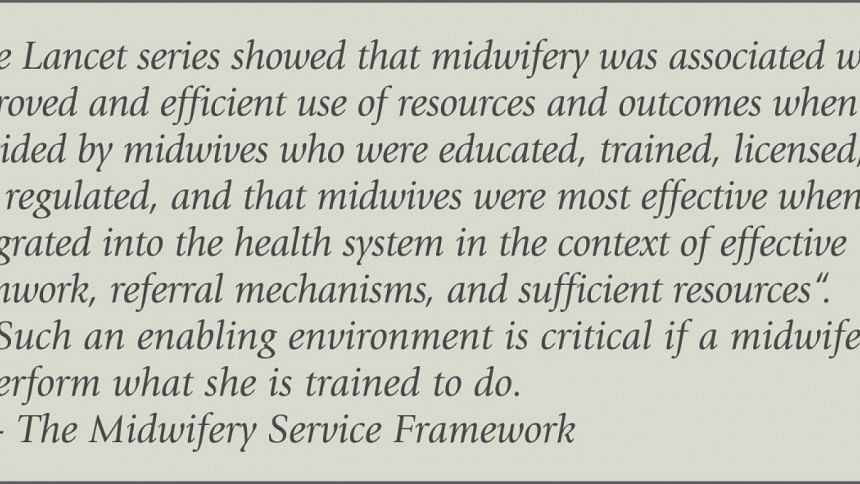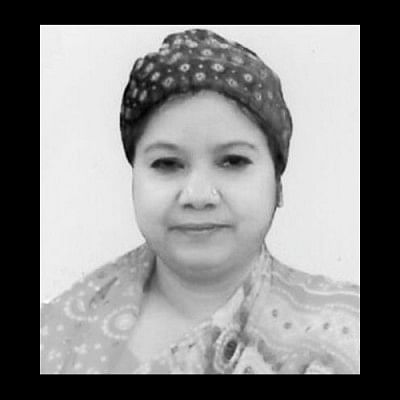Saving the lives of mothers and babies
The International Day of the Midwife, celebrated every year on May 5th, offers an opportunity to celebrate the contributions of midwives to the health and wellbeing of a nation. In Bangladesh professional, certified midwives have recently begun practicing, following the Prime Minister's commitment to creating 3000 posts for midwives in 2010. The first deployment of 600 midwives happened at the end of 2015. The next deployment will take place later this year.
Creating demand for midwives
Who is a midwife and what can she do that a doctor or nurse cannot do? A question which many women, husbands, mother-in laws, but also other health care professionals and the wider community members may be asking themselves. Communicating the range of services that a midwife can deliver to her clients is therefore a task which needs to be taken on by relevant Government and non-government institutions.

In order for this new profession to be successful a few critical factors are being addressed:
Midwifery education
Fundamental to the quality of the midwifery educationare the qualifications of the faculty and the options they have for professional learning and career development. Bangladesh currently does not have a dedicated midwifery faculty. Faculty members are drawn from the Nursing Colleges and other Medical Specialists. It is important to upgrade their skills to meet international criteria for midwifery training. The Government, with support from UNFPA has therefore launched an online one-year master's course in Sexual and Reproductive Health for the faculty teaching midwifery students. This master's program, just launched in Dhaka last month, will be taught by Darlana University in Sweden. This programme will work towards further developing faculty education, teaching and learning methods and the quality of the content they pass on to their students. Gaps between classroom and mentored clinical learning and supervision and role modelling will be continuously improved to assure a better prepared midwifery workforce.
Centers of Excellence for midwifery education
Providing students and newly graduated midwives with an enabling environment in which to practice is decisive for the successful practice of the new workforce. Along with a high quality pre-service educational programme, newly graduated midwives will need to have close in-service supervision. The clinical sites where students go to practice their midwifery skills and knowledge need to be supported, as well as ensuring that midwives will be enabled to practice autonomously in the facilities they are posted.
To showcase best practices in education and practice five Centers of Excellence (CoE) are in the process of establishment across the country: in Dhaka, Sylhet, Moulvibazar, Chittagong and Rangpur.
A CoE, in the context of Bangladesh, is an entity where the highest educational standards are maintained. They are the result of aggregated efforts of three different entities - Nursing Institutes/Colleges with an existing midwifery program, clinical training site and Upazila Health Complex with deployed midwives - which together enhance the results achieved in the educational institutes.
* Clinical education that will further improve the performance of practicing midwives will be a critical component of the CoE. A Upazila health center will be linked with the CoE and supported to provide quality midwifery led care. At this site midwives and midwifery students can practice a qualitative midwife-led continuum of care and respectful maternity care.
* International mentors with the support DFID have been deployed to four CoE to support the capacity and quality of faculty members of midwifery education in classroom and clinical sites.
* The Directorate of Nursing Services (DNS) will roll out an in-service on clinical preceptorship and mentorship to all midwifery programs starting this month
* a review of and evaluation of the midwifery educational programme will shortly be undertaken to upgrade the curriculum
Midwifery regulation, law and policy
The nursing and midwifery act that establishes the legal framework for midwifery has been approved at the highest level of the Government and is now before Parliament for clearance. A high level committee at the Ministry of Health and Family Welfare (MOHFW) is overseeing the work toward establishing needed regulation and administrative documents for practice. Working groups from the DNS, Bangladesh nursing and midwifery council (BNMC), and MOHFW have finalized job descriptions, Standard Operating Procedures for midwives, and a model for midwifery practice that will guide health facilities.
Midwifery Practice
Some of the 600 midwives who have been deployed are now working as midwives, while the MOHFW is working to address some barriers for all newly posted midwives to assume their postings. Orientations will begin this month of May 2016 for both posted midwives and their managers in order to support the transition to midwifery led care.
Closing Gaps in education and practice
* Meeting the ever evolving health needs of a growing population by increasing the numbers of midwives alone is not sufficient to ensure quality outcomes. There is a need to link the capacity of the faculty, the number of students graduating and the number of jobs available and the environment in which they will practice.
* A dialogue with other medical professionals, such as doctors and nurses, has begun and needs to continue, to ensure space for midwives to take the lead in performing normal maternal and newborn care from the time of planning a family, during pregnancy, delivery and post-delivery.
* The current student intake capacity of Nursing/Midwifery colleges is 975 a year. Based on a 2013 Human Resources for Maternal and Newborn Health assessment jointly carried out by the MOHFW and three UN agencies, and based on the number of births, the Country needs 22,000 midwives. To meet this number in five years, the in-take capacity of teaching institutions and “The Lancet series showed that midwifery was associated with improved and efficient use of resources and outcomes when provided by midwives who were educated, trained, licensed, and regulated, and that midwives were most effective when integrated into the health system in the context of effective teamwork, referral mechanisms, and sufficient resources“.
Such an enabling environment is critical if a midwife is to perform what she is trained to do.
The Midwifery Service Framework faculty would need to be drastically increased to at least 4,000 students a year, pointing to attention to both infrastructure and faculty.


The message is clear
Midwives areessential to achieving the Sustainable Development Goals. In the past 25 years, the world has almost halved maternal deaths. The SDG goal is to further reduce Maternal Mortality ratio to 70/100,000 or less from the current 170/100000. This is a goal within reach for Bangladesh. If deployed in larger numbers, professional midwives could avert approximately two thirds of maternal and neonatal deaths, especially if a targeted approach is taken to prioritize hard-to-reach areas and under-served populations groups.
1Filby A, McConville F, Portela A (2016), “What Prevents Quality Midwifery Care? A Systematic Mapping of Barriers in Low and Middle Income Countries from the Provider Perspective”, PLoS ONE, 11(5): e0153391, doi:10.1371/journal.pone.0153391, May 2016.
Source: UNFPA Team
The Daily Star talked to Ms. Shuraiya Begum, Registrar of the Bangladesh Nursing Council, regarding some core issues. The excerpt is produced here.

Today is the 5th May International Day of Midwife and the theme is “Women and New Born the Heart of Midwifery”, can you please give some insight about the women and new born health status in Bangladesh?
Shuraiya Begum: A new born baby is the heart to the midwives. They get a heavenly pleasure when it is born and they forget the pain she gets. As I am also a midwife and practiced it for a long time at home and abroad (As a Midwife she served in the medical institutions of Saudi Arabia for 10 years) I feel it better than others. Now, for some limitations I cannot continue the practice. I think every midwife feels as I feel. So mother and new born baby are the priority to the midwives. Health status of the women and new born in Bangladesh is satisfactory. You know, our Prime Minister got South-South Award for fulfilling the target of health. I think competitively our progress is better.
Bangladesh Government is committed to reducing Maternal Mortality below 70/100000 live birth by 2030, in this respect can quality midwife contribute to the reduction of Maternal mortality In Bangladesh?
Shuraiya Begum: Look, if we can produce skilled midwives, it is possible to achieve the goal before the targeted time. But in reality we are facing some challenges. Our midwives must have ability to face those challenges. We need to create proper environment to acquire the skill for practicing midwifery. In our country there exists a common psychology that caesarean delivery is only safe way for child birth. But few know that pregnancy is a very common physiological matter and it is very normal scenario all over the world. We should think of the alternatives only for some emergency cases like jaundice, diabetes, hypertension and over-weight baby. Otherwise we need not go for caesar. For the extreme case to save the life of a baby and its mother, we need to go for it. But it is seen that just for getting relief from labor pain our pregnant mothers often go for caesar. You know, even in the first world countries 80% of delivery takes place normally and 10-15% can be caesarean birth. But in Bangladesh It is the opposite scenario. So I think it is also a challenge for us.
As per commitment of Honourable Prime Minister Sheikh Hasina the government has already created 3000 midwifery posts and among them 600 have already been deployed. The newly deployed midwives need enabling conditions at the facility and community level to provide quality service, how the enabling environment can be ensured?
Shuraiya Begum: I appreciate our PM's initiatives and it is very good news for our women. I also appreciate that our government has also arranged for 4 Midwives in every Upazilla Health Complex and 1 in every local union. But there are some barriers which our midwives are facing now. Bed-setting is not prepared yet for the midwives. So how can they render services properly? They should be given the support whenever they need. So from the policy level these initiatives must be considered.
I personally request that the donor agencies should come forward regarding this sensitive issue. We know that the donor agencies are not the decision makers or core organisations, they are just supporting body. But they should be given the opportunity for setting up necessary mechanism in every Union Parishad level. I think our government is very much helpful and cooperative in this regard and I hope the donor agencies and our government will sit for it and come to a decision of joint venture regarding the midwives.
Interviewed by Sohel Rana

 For all latest news, follow The Daily Star's Google News channel.
For all latest news, follow The Daily Star's Google News channel. 



Comments